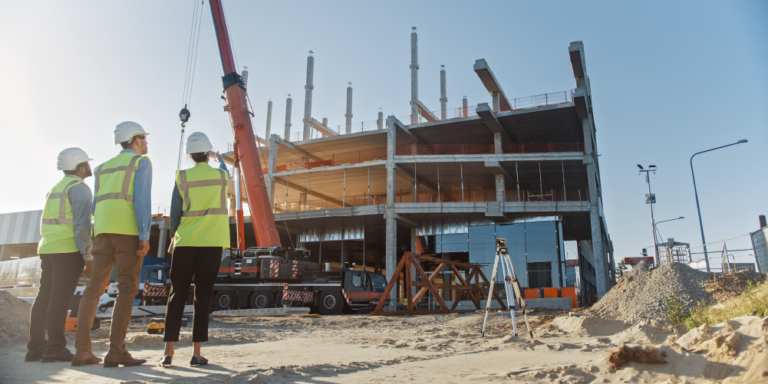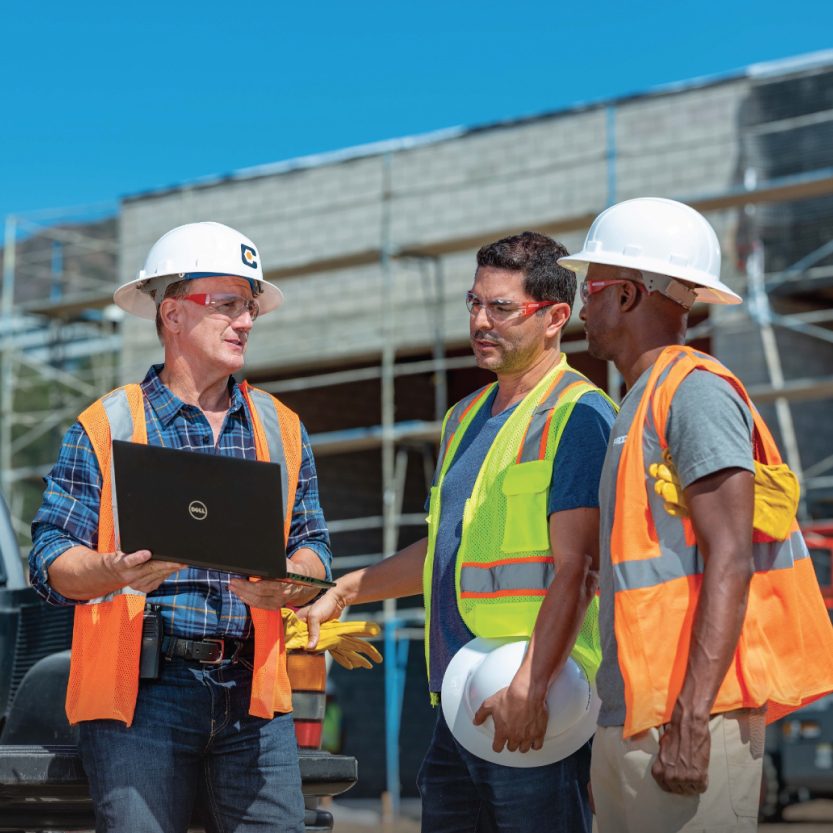— 11 min read
Commercial Construction Projects: What Sets Them Apart


Last Updated Aug 7, 2025

Jacob Kunken
Solutions Engineer, Heavy Civil
28 articles
Jake Kunken currently works as Solutions Engineer for Procore's Heavy Civil division. He brings 14 years of experience working in various construction roles in New York and Colorado, including laborer, assistant carpenter, carpenter, assistant superintendent, superintendent, construction manager, safety manager, and project manager. Jake also spent time in EHS as an environmental engineer for Skanska. He’s worked on more than 40 commercial projects from ground-up, to heavy civil, hospital work, and tenant improvement. Jake studied Ecological Technology Design at the University of Maryland.

Cait Bladt
13 articles
Cait Bladt is a multi-award winning freelance writer and producer. Her work has appeared at Vice, ABC News and Rolling Stone among others. She currently lives in Brooklyn with her cat Patricia.
Last Updated Aug 7, 2025

"Commercial construction" is a broad label for a highly varied field of construction. It covers jobs that are larger than four-unit residential buildings and differs from horizontal projects like roads and bridges that fall into the civil and infrastructure category.
Loan types, government oversight, rules and regulations are all different for commercial construction. As commercial jobs can include anything — from small retail shops to large residential construction, warehouses and big box stores — there is significant overlap among the types of projects.
This article will focus on the stages of commercial construction, what makes commercial projects different from other projects and best practices for general contractors (GCs) at every step of the process.
Table of contents
The Stages of Commercial Construction
In general, commercial construction projects progress through the same broad stages as any type of project (preconstruction, construction and post-construction). However, each stage involves some activities and requirements that are unique to the commercial sector -- particularly in comparison to residential projects.
Preconstruction
Acquiring Land and Air Rights
On commercial construction projects, there is a substantial amount of prep work that needs to be done before ground can ever be broken. In cities like New York, owners occasionally have to buy development rights, or air rights, from their neighbors or lobby to have laws changed to allow for new types of construction. Authorities Having Jurisdiction (AHJs) need to be consulted throughout to ensure zoning and permitting are completed properly and in a timely manner.
Feasibility Studies
Owners will need to determine whether there is a market for their commercial property in the area. Do residents need a grocery store or bank? Do they need large rental properties? The owners and developers use data points that determine whether or not there's market viability for their development in that region and consult the community as required by state or local standards.
Learn more about how construction feasibility studies work.
Additionally, they will need to determine whether the build is environmentally feasible. Soil and geological characteristics determine cost and workability of commercial projects. Flooding, high winds and other weather conditions must also be considered.
Funding and Bonding
Once a plan is created, a business loan must be secured and underwritten. Owners can either secure funding from a private entity or a bank. Going through a bank requires the entire business and construction plan to be heavily evaluated for feasibility and profitability. Underwriters will carefully investigate owners and GCs for any past indiscretions or other signs of significant risk. Both types of lenders, however, will be seeking a large ROI.
Along with acquiring a loan, GC’s have to secure bonds and insurance. This is where newer GCs will sometimes partner with larger, more established groups in order to increase their bonding capacity.
Planning
Owners will need to consider the many building codes that apply to the type of build they are working on. Warehouses will have different requirements than a multi-family property, for example. Access, egress, sprinklers, alarm systems and fire-resistant doors and walls are all different aspects that may be needed in commercial buildings based on local and federal regulations.
Planning needs to take into account any clashes and coordination issues. On residential construction, it is easier to reroute a pipe if it accidentally crosses paths with electrical. However, on large commercial projects, with so many different utilities running in the plenum space above the ceiling or behind the walls, these issues need to be identified well in advance to minimize risk of delays.
Get the Financial Guide to Commercial Growth
Learn more about key financial challenges before and during periods of expansion in commercial construction -- and strategies to tackle them.

Bidding
On non-commercial residential projects, GCs can typically use their preferred crews and subcontractors. With commercial construction however, especially when projects cross into public works projects, contracts are awarded to the lowest feasible bid. GCs must work carefully to bid level and ensure that one bid is not artificially decreasing their cost amount by leaving out specific line items.
Before taking any bids, GCs will usually do a rough take off and estimate a project’s overall cost. They will then reach out to subcontractors and add together the bids to see, generally, which ones will keep the project below budget. After that, bids are usually sent back to see if there is any way for subcontractors or suppliers to decrease their margin at all before making a final call.
Learn more: Winning Bidding Strategies for Construction
The bidding and scheduling process are excellent places to engineer value. Owners and GCs can both take ownership of any value engineering, by slightly padding estimates and working to lower them throughout the building process.
Procurement
Commercial projects usually require more bespoke and custom-made materials. In developed communities of single family homes, lead times can be short due to similar architectural selections. In large, multi-family projects the materials can be off the shelf, but the massive quantities dictate long lead times.
Construction
Budget Management and Auditing
During construction, banks will continue to check in on loans and payments. Banks will typically not cut checks to subcontractors until they have guaranteed that all materials have been used and all jobs have been completed. Overall, there are far more eyes watching the budget throughout a commercial construction project than a residential project.
Scheduling
Commercial construction schedules are typically tighter than on other types of projects. Buffer times still need to be scheduled to account for any errors or delays. Teams working on building schedules must identify which parts of the project are more by-the-numbers and less likely to be delayed, allowing for less lag time in the schedule.
On the other hand, more complicated portions of the work — ones that require inspections or bespoke materials — need more lag time. Times also need to be estimated in several different ways based on crew size: How long would it take for a crew of 4, 10, or 20 people to complete this task? If a job needs to be completed quickly, GCs can accelerate the schedule by requesting additional crews to work second or third shift, or on a different location.
Coordination
Throughout construction, crews, subcontractors and other stakeholders need to coordinate constantly. Large jobs will incorporate water, potable water, wastewater, and electrical shutdowns not only on the job site but also in surrounding areas. Large machinery like cranes must have an established swing radius to ensure the safety of nearby buildings and people. During the entire project, there need to be clear safety protocols and lockout/tagout procedures in case of any potential emergencies.
Finishing Materials
Finishing materials are typically prefabricated and ordered long in advance of their use. This allows more specificity in the schedule for when these materials will be delivered and utilized. Once the walls are closed in on a project, there is far less room for maneuvering and revising the schedule. Multiple trades can be working on the job during this final stage, meaning more finesse is needed to get the right person on the right part of the project at the right time.
Post-construction
Inspections
Before a project is fully handed off, the building needs to be awarded a temporary certificate of occupancy (TCO). This indicates that preliminary inspections have shown the building is safe. Any small jobs can be finalized and completed before final inspections are completed.
These last inspectors will check that all components are installed properly, all safety systems are in place and in working order, and everything is up to local and federal codes. Insurance investigators will visit afterward to check on aspects like expansion and contraction that would cause tiles or flooring to bend and crack in the future. Any mistakes they find will need to be fixed by the GC. After all of those fixes have been made, a final certificate of occupancy (CO) will be issued.
Additionally, commercial buildings must adhere to strict safety, environmental and accessibility requirements that differ from residential projects. Fire safety measurements need to be in place, including using fire resistant materials, fire protection systems and clearly marked emergency exits. The Americans with Disabilities Act (ADA) dictates accessibility requirements for commercial buildings.
Handover
Handover procedures and arrangements are agreed upon long before a project is completed. Similar to residential construction, all operations and maintenance (O&M) will be passed off. However much more time needs to be built into the schedule for this phase due to the high volume of appliances and equipment that are being handed over. The TCO and CO paperwork will be handed off as well.
Warranties and Retainage
Large commercial construction jobs typically carry a year-long warranty, during which the GC must address any problems that arise and can be attributed to the GC. Additionally, owners may choose to employ a retainage of 5%–15% of final payment held for 30 to 90 days after project completion. This ensures that GCs and subcontractors return quickly to fix any last-minute tasks or problems.
Commercial vs. Residential Projects
Single homes, duplexes, triplexes and quads constitute residential projects. However, any structure with more than four residential units is considered by many construction professionals as a commercial build.
Commercial buildings can also be mixed-use with business or restaurant spaces on the ground floor or throughout the building and apartments in the rest of the space.
On smaller residential projects, there are typically height and square footage limits. Owners are generally able to build residential structures as they see fit, but some municipalities may have certain aesthetic requirements that must be adhered to. Specialty contractors like electricians and plumbers will work on both residential and commercial projects. However, general contractors typically specialize in one of the other.
Additionally, financing, bonding and insurance are different for commercial projects. Commercial projects are larger and therefore significantly more expensive. Banks and private lenders require more oversight of both initial plans and ongoing construction to agree to financing. Many smaller companies will team up with larger GCs to increase their bonding capacity, due to the heavier financial load and higher degree of risk.
Commercial vs. Civil Projects
Civil projects include infrastructure – roads, bridges, tunnels, solar treatment plans, playground, etc. However, there are some joint ventures that could be crossovers between the civil projects and commercial builds.
Low-income housing is a perfect example of a commercial and civil project. In these instances, the government may provide tax credits for the owners and GCs, which would act as an incentive to banks looking at providing loans. Government involvement is often seen as an indicator that the project and funding is more stable than a totally private project.
Civil commercial projects require a more diligent bidding process. GCs are required to choose vendors and subcontractors with the lowest feasible bid, rather than opting to work with companies they may prefer. Overall there is just a far greater amount of oversight when the government is involved in the project.
Commercial Construction Best Practices
Focus on communication and coordination.
As with all construction projects, communication and coordination are of the utmost importance. Effective communication ensures that all parties are aligned on project timelines, budget constraints, and safety protocols — minimizing the risk of costly errors and delays. The easiest way to ensure everyone is on the same page is to communicate as much as possible through accessible channels.
Communicate externally — early and often.
Community members and authorities having jurisdiction (AHJs) also need to be informed about all work. Open communication also helps smooth over any problems that may come up. Communities are typically much more willing to allow workers to continue past an evening noise ordinance if workers have been respectful to their neighbors.
Take advantage of progress meetings.
Progress meetings are an important tool for keeping all construction parties aligned. These meetings enable proactive problem-solving — allowing for adjustments to be made in real-time — and help keep the project on track, minimizing delays and risks.
Utilize construction management software.
Using construction management software increases visibility and communication across teams. Programs and tools that allow data to be captured in real-time and shared with folks in the office and the field allow everyone access to changes and updates to the project and an opportunity to solve potential problems proactively.
Breaking Into the World of Commercial Construction
Commercial construction is a multifaceted and dynamic field that encompasses a wide range of projects — with distinct requirements at every stage of the construction process. Breaking into commercial construction can be challenging but ultimately rewarding: Contractors who can navigate the intricate landscape of commercial construction deliver projects that meet both regulatory requirements and client expectations.
Building a reliable network of subcontractors and suppliers, understanding the specific bidding processes, and communicating effectively are all essential for success. Contractors looking to get into commercial construction may also benefit from partnering with established companies to increase bonding capacity and secure larger projects.
Learn more: Guide to Breaking Into Commercial Construction
Was this article helpful?
Thank you for your submission.
0%
0%
You voted that this article was . Was this a mistake? If so, change your vote
Scroll less, learn more about construction.
Subscribe to The Blueprint, Procore’s construction newsletter, to get content from industry experts delivered straight to your inbox.
By clicking this button, you agree to our Privacy Notice and Terms of Service.
Thank you!
You’re signed up to receive The Blueprint newsletter from Procore. You can unsubscribe at any time.
Categories:
Written by

Jacob Kunken
Solutions Engineer, Heavy Civil | Procore Technologies
28 articles
Jake Kunken currently works as Solutions Engineer for Procore's Heavy Civil division. He brings 14 years of experience working in various construction roles in New York and Colorado, including laborer, assistant carpenter, carpenter, assistant superintendent, superintendent, construction manager, safety manager, and project manager. Jake also spent time in EHS as an environmental engineer for Skanska. He’s worked on more than 40 commercial projects from ground-up, to heavy civil, hospital work, and tenant improvement. Jake studied Ecological Technology Design at the University of Maryland.
View profile
Cait Bladt
13 articles
Cait Bladt is a multi-award winning freelance writer and producer. Her work has appeared at Vice, ABC News and Rolling Stone among others. She currently lives in Brooklyn with her cat Patricia.
View profileExplore more helpful resources

Why do most construction strategies fail (and how to fix them)?
In this episode of The Power of Construction, hosts Sasha Reed and Brett King sit down with Helen Gawor, a strategist and transformation expert who challenges construction’s approach to strategy....

How AI Is Creating Big Advantages for Specialty Contractors
Every minute that an MEP contractor takes to file an RFI, untangle a scheduling knot, or search for a forgotten document is a minute spent not building something. Enter artificial...

How GCs Can Minimize Waste With a Strong Inventory Management System
Construction is a very fluid and fast-paced industry. Any given jobsite might have thousands of moving pieces, plus new items showing up on the loading dock day after day. In...

Construction Business Intelligence: From Data to Decisions
Leaders in the construction industry can now access a vast array of construction data through sophisticated construction business intelligence tools. Within this data lie insights that support daily decision-making and...
Free Tools
Calculators
Use our calculators to estimate the cost of construction materials for your next project.
Templates
Find a template to help you with your construction project tasks.
Material Price Tracker
Get the latest U.S. retail prices and view historical trends for common building materials.
Glossary
Explore key terms and phrases used in the industry.
